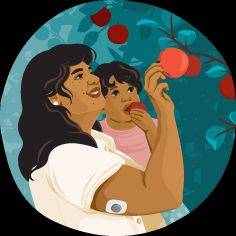Bananas may be known as potassium-rich foods, but you can also get potassium from avocados, sweet potatoes, spinach, coconut water, and other delicious foods and drinks.
Potassium is a
It’s considered an essential nutrient because your body can’t produce it. Therefore, you must get potassium from foods to meet your recommended daily needs, known as the Daily Value (DV).
The DV for potassium is
A medium banana contains around
Keep reading to learn more about 18 foods that are high in potassium.
Avocados are packed with healthy fats, vitamin K, and folate.
Half an avocado without the skin and seed (68 grams [g]) contains
What’s more, avocados may help you manage high blood pressure, especially if you might need to increase your potassium intake and reduce your sodium intake. Like most other fruits, avocados are low in sodium, with half an avocado providing just
2. Watermelon
Watermelon is a large, delicious fruit with high water content.
Just 2 wedges (about 1/8 of a melon, or 572 g) provide just under
3. Butternut squash
Butternut squash is a sweet-tasting winter squash. While technically a fruit, it’s cooked like a root vegetable.
Just 1 cup (140 g) of cooked butternut squash provides
You can easily roast, boil, steam, or chop butternut squash for dishes such as baked veggies or hearty soups.
4. Dried apricots
Dried apricots have a long shelf life and are usually pitted. A 1/2-cup (65 g) serving provides
These fruits are also a good source of fiber and vitamins A and E.
Dried apricots are delicious mixed into muesli or as a healthy snack for hikes or camping trips.
5. Pomegranate
Pomegranates are a many-seeded fruit that vary in color from red to purple. One whole fruit (282 g) gives you
Moreover, pomegranates are packed with folate and vitamins C and K. They also pack more protein than most other fruits, at 4.7 g per fruit (282 g).
6. Tomatoes
Tomatoes are high in nutrients and antioxidants. Although they’re botanically classified as a fruit, they’re usually prepared and used in dishes as vegetables.
A 1-cup (180 g) serving of raw tomatoes provides
Tomatoes can be used in a wide range of dishes, either cooked or raw.
7. Sweet potatoes
Sweet potatoes are often used as an alternative to white potatoes.
They’re also a nutritious way to support your potassium intake. A 1-cup (200-g) serving of baked sweet potato boasts
What’s more, sweet potatoes are a great source of vitamin A, which is critical for
For a balanced and filling meal, you can pair these delicious root vegetables with a protein source such as beans or meat, some dark greens or colorful vegetables, and a little fat.
8. Spinach
Spinach is one of the most nutrient-dense vegetables.
A 3-cup (90 g) serving of raw spinach contains roughly
9. Potatoes
Potatoes are a starchy root vegetable that remains a staple food in numerous countries.
One medium raw potato with skin (213 g) offers
However, there are many varieties of potatoes, and their potassium content may depend on the soil in which they’re grown.
How to peel potatoes
10. Swiss chard
Swiss chard, also known as silverbeet or simply chard, is a leafy green vegetable with a thick stalk that ranges from red to orange to white in color.
It’s also highly nutritious. Just 1 cup (175 g) of cooked chard offers
The same serving packs 476% of the DV for vitamin K and 60% of the DV for vitamin A, all while being low in calories and high in fiber.
Swiss chard makes a delicious base for salads and is easy to steam or sauté with a little oil.
11. Beets
Just 1 cup (170 g) of boiled red beets provides
Plus, this root vegetable contains nitrates. When converted into nitric oxide in your body, nitrates may help support blood pressure management and overall heart health.
Beets are also an excellent source of folate — a vitamin needed for
You can eat beets boiled, pickled, or raw.
12. Yams
Yams are starchy tubers popular in South America, Western Africa, and the Caribbean. They’re very similar to yucca or cassava, but their flesh varies in color from yellowish-white to purple or pink.
Yams are rich in potassium, with 1 cooked, cubed cup (136 g) providing
13. Coconut water
Coconut water is a particularly hydrating drink.
It’s an excellent natural alternative to sports drinks, as it contains key electrolytes that help draw water into your cells. Its natural sugars may also provide energy during exercise and help replenish lost glycogen stores afterward.
Just 1 cup (250 milliliters [mL]) of unsweetened coconut water contains
Coconut water is very refreshing when served chilled with ice after a sweaty workout. Just make sure to avoid varieties with added sugar.
14. Fruit and vegetable juices
Drinking natural fruit and vegetable juices is another easy way to increase your potassium intake.
For example, 1 cup (262 g) of 100% orange juice offers about
Juices from potassium-rich fruits such as pomegranates are also great alternatives. A 1-cup (249 g) serving of pomegranate juice packs
Some vegetable juices are also rich in this mineral.
For instance, 1 cup (236 g) of carrot juice boasts
15. Beans
Beans are a nutritious source of complex carbs and plant-based protein.
Just 1 cup (179 g) of cooked white beans has twice as much potassium as a banana, clocking in at
16. Legumes
Aside from beans, the legume family includes lentils, chickpeas, soybeans, and peanuts — all of which are high in potassium.
Here are the DV for potassium in a 1-cup serving:
- Lentils (198 g, cooked):
15%Trusted Source - Chickpeas (164 g, cooked):
10%Trusted Source - Soybeans (172g, cooked):
19%Trusted Source - Peanuts (28 g, raw):
4%Trusted Source
Legumes can be used in a wide range of dishes, including chilis, stews, pastas, and breads, among others.
17. Fish
Certain lean and fatty fish are rich in potassium. For instance, when cooked:
- Cod (170 g):
13%Trusted Source of the DV - Haddock (150 g):
11%Trusted Source of the DV - Salmon (154 g):
16.5%Trusted Source of the DV - Canned tuna (172 g):
9%Trusted Source of the DV
In addition, fatty fish such as salmon and tuna are rich in heart-healthy omega-3 fatty acids, which may further reduce your risk of heart disease.
18. Salt substitutes
Salt substitutes were designed to help reduce sodium intake because excess salt consumption may lead to high blood pressure and other cardiovascular conditions.
These substitutes replace sodium with another element or mix of elements — typically potassium — to reduce heart disease without reducing perceived salt intake or diminishing the taste.
Unlike regular salt, which is 100% sodium chloride, salt substitutes may be composed of 65% sodium chloride, 25% potassium chloride, and 10% magnesium sulfate. Others may offer 100% potassium chloride, which packs 11% of the DV in just 1 g.
However, people with kidney or liver disease may need to avoid salt substitutes that are high in potassium.
Foods that are good sources of potassium include dried fruit, lentils, spinach, sweet potatoes, and orange juice.
Adding potassium to the diet or taking supplements, if a doctor recommends, can increase your potassium levels.
Early symptoms of hypokalemia (low potassium) may include:
A more severe deficiency can lead to an increase in diluted urine, muscular paralysis, and heart palpitations, among other symptoms.
Although bananas are a good source of potassium, many other nutritious foods, including sweet potatoes, legumes, and beets, offer more potassium per serving. Swiss chard, yams, and white beans even have twice as much potassium per cup as a medium banana.
The key to getting enough potassium is to eat a range of plant foods each day. Certain fish, such as salmon, tuna, and cod, are good animal-based sources of this mineral, too.






